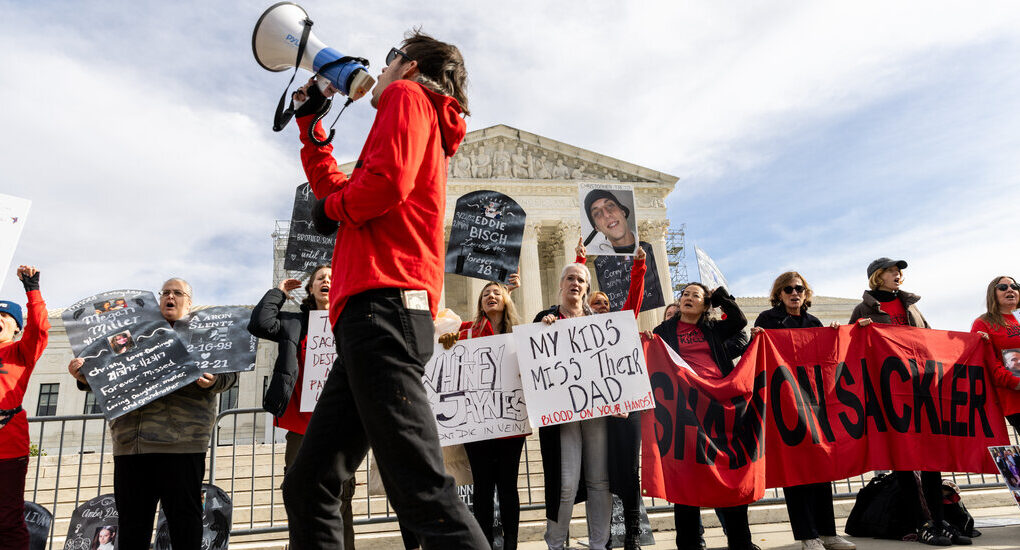The Supreme Court justices seemed divided on Monday over a fiercely contested bankruptcy settlement for Purdue Pharma that would funnel billions of dollars into addressing the opioid epidemic in exchange for shielding members of the wealthy Sackler family from related civil lawsuits.
The U.S. Trustee Program, an office in the Justice Department, had challenged the deal for Purdue, the maker of the prescription painkiller OxyContin. It said the agreement violated federal law by guaranteeing such wide-ranging legal immunity for the Sacklers, who once controlled the company, even though they themselves had not declared bankruptcy.
Questions from the justices reflected why the deal has drawn intense criticism in a dispute that pits money against principle. Under debate was the practical effect of unraveling the agreement, painstakingly negotiated for years for victims and families who have urgently sought settlement funds, and broader concerns over whether releasing the Sacklers from liability would free them from further scrutiny over their role in the opioid crisis.
A decision in the case could also have consequences for similar agreements resolved through the bankruptcy system that have been structured to insulate a third party from liability.
“The opioid victims and their families overwhelmingly approve this plan because they think it will ensure prompt payment,” Justice Brett M. Kavanaugh said. He asked why the government was pushing to end a tactic approved over “30 years of bankruptcy court practice.”
The lawyer for the government, Curtis E. Gannon, acknowledged that tension, but he argued that the U.S. trustee “has been given this watchdog role” and that a ruling for the government would not foreclose an opioid deal with the Sacklers. He noted that after a federal judge rejected the deal, the Sacklers increased their cash offer, to $6 billion from roughly $4 billion, to settle thousands of claims.
Justice Amy Coney Barrett raised what a victory for the U.S. trustee would mean “for other victims of mass torts,” including plaintiffs who have accused the Boy Scouts of America and the Catholic Church of sexual abuse. Those settlements have included similar releases of liability, known as third-party nonconsensual releases.
Mr. Gannon responded that Congress could pass legislation that specified how such deals could work. It was not the government’s role, he said, to speak for victims but rather to be “concerned about the entire process.”
Inside the crowded courtroom, the justices appeared deeply engaged, leaning forward periodically during two hours of argument.
Their questions did not appear to line up along ideological lines, signaling the decision could be closely divided.
Justice Ketanji Brown Jackson seemed skeptical that releases of liability were the only way to compensate opioid victims, asking why the agreement needed to be reached through bankruptcy court.
A lawyer for victims’ groups, Pratik A. Shah, insisted that the releases were critical to the deal. Otherwise, he said, members of the Sackler family would not sign on to an agreement, which risked leaving victims with nothing.
“Without the release, the plan will unravel,” he said. “There will be no viable path to any victim recovery.”
“Well, that sounded very emphatic,” Justice Elena Kagan replied, to laughter.
Justice Kagan appeared to be puzzling through her views from the bench. She seemed doubtful of the U.S. trustee’s position and asked whether the government was standing in the way of an agreement that had the overwhelming approval of victims. They are among those “who think that the Sacklers are pretty much the worst people on Earth,” she added.
But she later pointedly asked whether such deals subverted the bankruptcy process: Did the settlement allow wealthy people like the Sacklers to shield themselves from lawsuits, including claims of fraud, without putting “anything near their entire pot of assets on the table?”
“In some ways, they’re getting a better deal than the usual bankruptcy discharge,” Justice Kagan said, because “they’re being protected from claims of fraud and claims of willful misconduct.”
Justice Jackson seemed to share those concerns. She described frustrations voiced by the original bankruptcy judge that the Sacklers had moved money out of Purdue into offshore accounts. The Sacklers “took the assets from the company, which started the set of circumstances in which the company now doesn’t have enough money to pay the creditors,” she said.
Outside the courtroom, dozens of demonstrators called on the justices to overturn the bankruptcy deal, saying that they believed it did little for families of victims and failed to hold the Sacklers to account.
Many wore red T-shirts that read “Sackler v. the people” under an image of the Supreme Court and brandished signs with photos of family members who had died from drug overdoses.
“I don’t want their money,” said Ralph DeRigo, who said one of his sons had died of an opioid overdose in 2014 and another had struggled with addiction. “They should lose it or, at least, every bit that they made on OxyContin.”
He added that he did not believe a cash settlement would bring justice: “I think they should be in jail.”
A decision could come as late as June, near the end of the court’s term.
In recent years, bankruptcy court has become a popular place to deal with mass-injury settlements.
In agreeing to take the case, the Supreme Court temporarily halted the deal, most likely suspending payments to plaintiffs until it issues a ruling.
The U.S. trustee had asked the court to intervene after an appeals court upheld the settlement. The agreement allowed the Sacklers to take advantage of protections meant for those in “financial distress,” the government said, offering “a road map for wealthy corporations and individuals to misuse the bankruptcy system.”
Lawyers for Purdue said in court filings that the plan would “provide billions of dollars and lifesaving benefits to the victims of the opioid crisis.” Striking down the deal, they added, would jeopardize that. The suggestion that the plan laid out a strategy for the rich seeking to avoid accountability was “unfounded,” they added.
Purdue, which is widely viewed as helping to spark the opioid crisis, has faced a flood of challenges since OxyContin’s addictive qualities and potential for abuse became clear.
The company continued to aggressively push the painkiller regardless. In 2007, a holding company for Purdue pleaded guilty to a felony charge of “misbranding” the drug, including its risk of addiction, and agreed to pay some $600 million in fines and other fees.
As the number of overdose deaths soared, municipalities, tribes, families and others sought funding to address the ravages of the drugs. Many pinned much of the blame on OxyContin.
Purdue filed for bankruptcy protection in September 2019 as civil lawsuits against the company and, increasingly, the Sacklers themselves mounted.
Under a restructuring plan, filed in March 2021, the company would dissolve and become a public benefit company focused on trying to counter the opioid epidemic. In turn, members of the Sackler family would pour billions from their personal fortune into aiding states, municipalities, tribes and others in fighting a public health crisis that has left hundreds of thousands of people dead. More than 90 percent of the plaintiffs who voted on the plan approved it.
That September, Judge Robert Drain of the U.S. Bankruptcy Court in White Plains, N.Y., approved the plan. The U.S. Trustee Program was among those that appealed the decision.
As an appeal wound through the courts, members of the Sackler family increased their cash offer in February 2022 to settle the thousands of opioid claims up to $6 billion. They continued to insist that they be insulated from all opioid-related lawsuits.
The United States Court of Appeals for the Second Circuit ruled in favor of the plan more than a year later, handing a victory to Purdue and prompting the U.S. trustee to appeal.
Jan Hoffman contributed reporting from New York, and Aishvarya Kavi from Washington.



